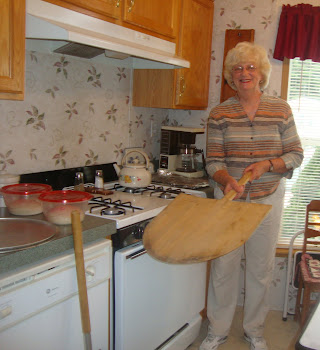The flours were sifted for both of these experimental doughs. They were both mixed by hand.
I am also going to try out another small frozen dough ball that is my regular preferment for the Lehmann dough. I will post when the experiments are baked.
First picture water and beer liquid used to ferment the dough.
Second picture two experimental doughs, with cake yeast dough on left and beer yeast dough on right.
Third picture is bottle of beer, that I didn’t drink.
Since it has been hot in our area, and I really don’t like to turn the oven on unless I have to. I am using the BBQ grill set-up again today to see what kind of results can be achieved, in 3 different doughs.
I also picked three kinds of tomatoes from my garden to dress the 3 pies. They were one kind of San Maranzo, grape tomato, and Amish Paste. I tasted all of them and the grape tomatoes are the sweetest. I used 6 in 1 sauce and Foremost Blend of cheese also to dress the pies. I picked some opal and regular basil to top the pies after baking. The first pie I used the grape tomatoes, which was my regular preferment dough. I decided at the last minute not to use a small dough ball and see what would happened in the bake using a regular sized dough ball, but letting it much thicker. The second pie, which was the cake yeast pie, I used the Amish Paste Tomato. The third pie which was made from the sediment from the beer, I used the San Mananzo tomato.
In all, I think all of these pies were good and all the crusts had a different taste. I would have let the cake yeast dough and the beer sediment dough ferment longer, but it soon was going to get dark outside, so I decided to use them before it got dark. All the doughs were easy to open and didn’t show signs of overfermentation.
I baked the preferment for the Lehmann dough first, The cake yeast pie second and the beer sediment pie last. The pictures are below of how the cake yeast dough looked and also the beer sediment dough on the top and underside of the dough, so it can be seen how the dough looked before the bake. I don’t know why but the cake yeast dough did expand more than the beer sediment dough, but the cake yeast dough didn’t have as many bubbles on the bottom.
In conclusion, I still am mystified how dough works and also how different yeasts can produce different results. The only reason I changed the formula to include Kyrol flour as the main flour, was because in my last bake the crust rim didn’t get as brown as I wanted, and I know I don’t have a set-up for the BBQ grill to get to much higher temperatures.
I took the temperature of the bottom firebricks and bottom of the steel pan before each bake. As can be seen the temperatures did go up until I opened and dressed each pie.
First pie, bottom firebricks 535 degrees F. Bottom of steel pan 537 degrees F
Second pie, bottom firebricks 628 degrees F Bottom of steel pan 592 degrees F
Third pie, bottom firebricks 672 degrees F. Bottom of steel pan 657 degrees F.
Another thing about baking these pies that I am curious about is the first pie, that was left really thick, didn’t need a pan put on the bottom after baking for awhile. It browned okay without using any pan and didn’t burn.
This post needs some pep, so here are two videos from that summer night, to give this post some pep.
“Ladies’ Night”
http://www.youtube.com/watch?v=2O_9L9TVLHs
For baking music, this is good.
“Oh What A Night”
http://www.youtube.com/watch?v=Pvdk4kzpW3U
Which pie do others think would taste best, just by looking at them?
Norma






No comments:
Post a Comment